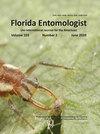Insights into the Use of a Mass Trapping Strategy to Control Fruit Fly Populations (Diptera: Tephritidae) in Guatemala: A Study Case in a Citrus Growing-Area
IF 1.2
4区 农林科学
Q3 ENTOMOLOGY
引用次数: 0
Abstract
Abstract Mass trapping is a control method for fruit fly pests (Diptera: Tephritidae) in fruit-growing areas. This study aimed at providing information on the use of mass trapping using Cera Trap® to control fruit fly pests in a citrus-growing area in Guatemala. We analyzed the “flies per number of traps × exposure d” index and sex ratios of fly populations based on 3 trapping types: a mass trapping network, a monitoring trap in the center of a plot involving mass trapping, and another trap installed in a plot without mass trapping. Sex ratios within and between trapping types, as well as the flies per number of traps × exposure d between trapping types were compared. Eleven fruit fly species were identified, and 4 of them were used in the analysis: Anastrepha ludens (Loew), Anastrepha distincta (Greene), Anastrepha serpentina (Wiedemann), and Ceratitis capitata Wiedemann (all Diptera: Tephritidae). No differences in the sex ratio were observed between the trapping types, but it was female-biased within mass trapping. A negative effect of mass trapping on the flies per number of traps × exposure d of pest populations was noted. We discussed the use of mass trapping highlighting citrus agroecosystems as a shelter for fruit fly communities including pest species. Further research on agroecological variables and their effect on the mass trapping strategy is suggested. Resumen El trampeo masivo es un método de control para plagas de moscas de la fruta (Diptera: Tephritidae) en áreas frutícolas. Este estudio tuvo como objetivo proveer información sobre el uso del trampeo masivo con Cera Trap® para el control de plagas de moscas de la fruta en áreas citrícolas de Guatemala. Se analizó el índice de “moscas por número de trampas × días de exposición” and la proporción de sexo de las poblaciones de mosca basados en 3 tipos de trampeo: una red de trampeo masivo, una trampa de monitoreo en el centro del sitio involucrando el trampeo masivo, y otra trampa instalada en otro sitio sin trampeo masivo. Se comparó las proporciones de sexo dentro y entre los tipos de trampeo, así como las moscas por número de trampas × exposición dia entre los tipos de trampeo. Once especies de moscas de la fruta fueron identificadas, y 4 de ellas fueron utilzadas en el análisis: Anastrepha ludens (Loew), Anastrepha distincta (Greene), Anastrepha serpentina (Wiedemann), and Ceratitis capitata Wiedemann (todos Diptera: Tephritidae). No se observaron diferencias en la proporción de sexo entre los tipos de trampeo, sin embargo, hubo un sesgo hacia las hembras dentro del trampeo masivo. Se determinó un efecto negativo del trampeo masivo sobre las moscas por número de trampas × exposición dia. Se discute el uso del trampeo masivo destacando los agroecosistemas citrícolas como refugio de comunidades de moscas de la fruta incluyendo las especies plaga. Se sugiere mayor investigación sobre variables agroecológicas y su efecto en la estrategia de trampeo masivo.在危地马拉使用大规模诱捕策略控制果蝇种群(双翅目:蝗科)的见解:以柑橘种植区为例
摘要质量诱捕是水果种植区果蝇(双翅目:蝇科)的一种控制方法。这项研究的目的是提供关于使用CERA陷阱使用大规模陷阱的信息® 控制危地马拉柑橘种植区的果蝇害虫。我们根据3种诱捕类型分析了“每陷阱数量×暴露d的苍蝇”指数和苍蝇种群的性别比:一个大规模诱捕网络,一个位于涉及大规模诱捕的阴谋中心的监测陷阱,以及另一个安装在没有大规模诱捕的阴谋中的陷阱。比较了陷阱类型内和陷阱类型之间的性别比,以及陷阱类型之间每陷阱数量×暴露量的苍蝇。确定了11种果蝇物种,其中4种用于分析:Anastrepha ludens(Loew)、Anastrepha distincta(Greene)、Anastrepha serpentina(Wiedemann)和Ceratitis capitata Wiedemann(均为双翅目:体节动物科)。诱捕类型之间的性别比没有差异,但在大规模诱捕中存在女性偏见。注意到按陷阱数量×接触害虫种群对苍蝇的大规模诱捕产生了负面影响。我们讨论了使用大规模诱捕,突出柑橘农业生态系统作为包括害虫物种在内的果蝇群落的避难所。建议进一步研究农业生态变量及其对群众诱捕策略的影响。摘要大规模诱捕是水果产区果蝇(双翅目:蝇科)害虫的一种控制方法。这项研究的目的是提供有关使用带有陷阱蜡的大规模陷阱的信息® 用于控制危地马拉柑橘种植区的果蝇害虫。根据三种陷阱类型分析了“陷阱数量×暴露天数的苍蝇”指数和苍蝇种群的性别比例:一个大规模陷阱网络,一个位于涉及大规模陷阱的站点中心的监测陷阱,以及另一个安装在另一个没有大规模陷阱的站点上的陷阱。比较了陷阱内和陷阱类型之间的性别比例,以及陷阱数量×暴露日的苍蝇在陷阱类型之间的比例。确定了11种果蝇,其中4种用于分析:Anastrepha Ludens(LOEW)、Anastrepha distincta(Greene)、Anastrepha serpentina(Wiedemann)和Ceratitis capitata Wiedemann(均为双翅目:毛蝇科)。在不同类型的陷阱中,性别比例没有差异,但在大规模的陷阱中,对女性有偏见。通过陷阱数量×每天暴露量,确定了大规模诱捕对苍蝇的负面影响。通过强调柑橘农业生态系统作为果蝇群落(包括害虫物种)的避难所,讨论了大规模捕猎的使用。建议进一步研究农业生态变量及其对大规模诱捕策略的影响。
本文章由计算机程序翻译,如有差异,请以英文原文为准。
求助全文
约1分钟内获得全文
求助全文
来源期刊

Florida Entomologist
生物-昆虫学
CiteScore
2.10
自引率
7.10%
发文量
44
审稿时长
3 months
期刊介绍:
Florida Entomologist is the official journal of the Florida Entomological Society. Volumes 1-3 were published under the name The Florida Buggist. The Florida Entomological Society still produces the traditionally printed version of Florida Entomologist, but you can also view, search, or print any article published since June 1917 by accessing online files. Web access is made possible by the Society’s electronic publication project begun in 1993
 求助内容:
求助内容: 应助结果提醒方式:
应助结果提醒方式:


